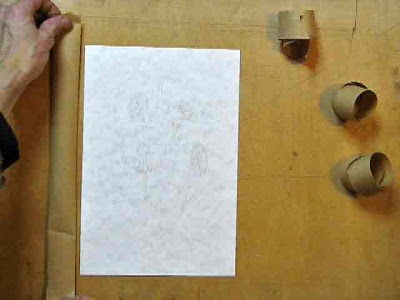For a few days I had trouble starting the presentation. Here I give some explanations in traditional form.
 Sometimes I do the drawing first - before I stick paper to the board. when I don't have the mood and make mistakes I just take a new card and do not have to detach it. It is hard to wipe off pencil if its overdrawed end watercolor go dirty. It is better that the picture was as delicate. This order is not necessary but possible, and who will.
Sometimes I do the drawing first - before I stick paper to the board. when I don't have the mood and make mistakes I just take a new card and do not have to detach it. It is hard to wipe off pencil if its overdrawed end watercolor go dirty. It is better that the picture was as delicate. This order is not necessary but possible, and who will. I am filling the bath with water and dip my sheet for 5 - 10 minutes. Paper has to get wet and soft but dissolves the glue which is a component of paper, so it is not advisable to soak it too long.
I am filling the bath with water and dip my sheet for 5 - 10 minutes. Paper has to get wet and soft but dissolves the glue which is a component of paper, so it is not advisable to soak it too long. I put paper on a towel and gently let the water soak in it After a while the paper is damp but not wet, it is not shinnig.
I put paper on a towel and gently let the water soak in it After a while the paper is damp but not wet, it is not shinnig. Now, I'm moisturizing previously prepared pieces with the wet sponge and tape the paper, clamp it firmly. If the tape is badly affixed to the paper it will bend.
Now, I'm moisturizing previously prepared pieces with the wet sponge and tape the paper, clamp it firmly. If the tape is badly affixed to the paper it will bend. Now I leave the paper for the night to dry. On the next day I start to paint. This is my method that I like to work that way. I often prepar few sheets of clean paper or with sketches and I have a spare ready to paint. I use plywood as a drawing board. In some areas, tape did not want to keep.
Now I leave the paper for the night to dry. On the next day I start to paint. This is my method that I like to work that way. I often prepar few sheets of clean paper or with sketches and I have a spare ready to paint. I use plywood as a drawing board. In some areas, tape did not want to keep.When my painting is done and dry it must be cutted off so the size of paper that I prepared at the beginning declines. I soak the tape which is left on the board and scrape it off with spatula.


















